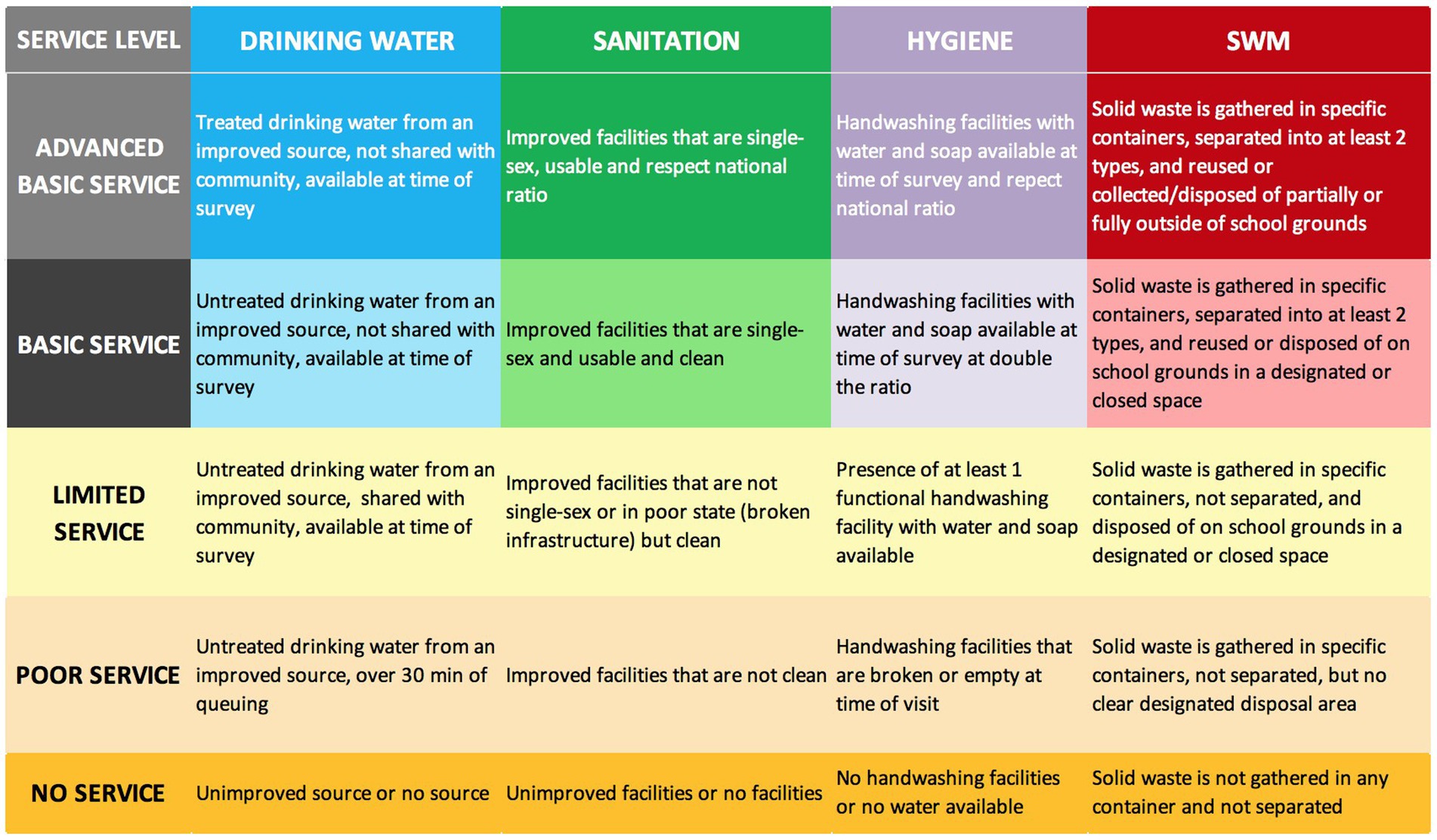- 1Eawag – Swiss Federal Institute of Aquatic Science and Technology, Dübendorf, Switzerland
- 2Department of Civil, Environmental and Geomatic Engineering, ETH Zürich, Zürich, Switzerland
- 3Department of Civil and Environmental Engineering, Makerere University, Kampala, Uganda
The status of Water, Sanitation, and Hygiene (WASH) in schools in sub-Saharan Africa remains dire. Only 46% have access to basic water services, 44% to basic sanitation services, and 26% to basic hygienic services. Although integrating these services with other water and waste streams could benefit service provision, a systematic methodology for such integration does not exist yet. This research approaches a first step–a methodology for an integrated assessment of water, sanitation, and solid waste management (SWM) services in schools. In addition, a modified version of the Joint Monitoring Program’s WASH service ladder for schools is provided for a detailed understanding of the service levels. A total of 16 schools from two small towns in Uganda are taken as case studies to identify the current service levels, interlinkages between the sectors as well as their enabling environment. Using surveys, stakeholder interviews, observations, and water quality measurements, the results show several cross-contamination pathways leading to exposure of pupils to pathogens. Finance and policies are major inhibitors of positive interlinkages and limited skills and capacities amplify negative interlinkages. The results emphasize the need for a shift toward further integrated planning of the water and waste services in schools and other institutions.
1 Introduction
Access to safe drinking water, adequate sanitation facilities, and proper management of solid waste are crucial for healthy and thriving human settlements. These services are integral to maintaining public health, ensuring environmental sustainability, and fostering socio-economic progress. Inadequate access to such services results in preventable illnesses that disproportionately affect vulnerable populations, including children, the elderly, and those living in poverty. Unsafe WASH led to 1.4 million deaths and 74 million disability-adjusted life years (DALYs) in 2019 (WHO, 2019). Yet, 2.2 billion people lack access to safely managed drinking water services, while 4.2 billion lack access to safely managed sanitation services (WHO, 2019). These statistics highlight the urgent need to prioritize the provision of WASH services to alleviate the burden of diseases, enhance quality of life, and promote equitable development (UN, 2021).
Schools are a key institution linking children, education, accessibility to WASH facilities, and consequently drive exposure to pathogens to households and communities. They are at the centre of the development of human settlements providing daily shelter for children, some of whom are vulnerable population and should sensitively address their needs. WHO and UNICEF’s Joint Monitoring Program (JMP) that specifically looks at the progress of WASH access in schools, has identified that the service levels are urgently needing improvement in sub-Saharan Africa (UN, 2022; UNICEF, 2023). While less than half of the schools in this region have access to basic water and sanitation services, only 26% have access to basic hygienic services (UNICEF and WHO, 2021a; Bolatova et al., 2021). Not only does access to adequate WASH facilities ensure the wellbeing, health and dignity of students, but also affects the regular attendance, especially of girls as well as the practices brought from school to home.
The COVID-19 pandemic triggered closer attention to the WASH situation in schools of low- and middle-income contexts. A review study Poague et al. (2022) assessed that the WASH school infrastructure and menstrual hygiene management in 30 low- and middle-income countries (LMICs) was largely insufficient, raising major concern toward strategies to contain the spread of the SARS-CoV-2. JMP highlighted that three in four schools lacked access to basic handwashing facilities at the start of the pandemic, leading to increased exposure to disease transmission (UNICEF and WHO, 2022). Similarly, improving solid waste management in schools has been identified as a priority for pandemic preparedness and response (UN, 2021; UNICEF and WHO, 2022).
Despite the inherent links between water, sanitation, and solid waste sectors, their planning and management are often siloed, including in schools (Narayan et al., 2021; Lüthi et al., 2017; Marshall and Farahbakhsh, 2013). Interlinkages are the direct interactions between different steps of the service chains across sectors, which could be both infrastructural but also management aspects. Accounting for these interlinkages during planning and implementation is crucial to avert potential failure. For example, improper disposal of solid waste can contaminate water sources and compromise water quality (Narayan et al., 2021). To understand the situation of water, sanitation and solid waste and their interlinkages in schools, an integrated assessment for WASH and SWM in that context is necessary, but currently does not exist. Based on the earlier conceptualization (Narayan et al., 2021), it is useful to note that hygiene is not represented as a separate sector but is understood as part of both water supply and sanitation, underlining again the intrinsic connection between both sectors.
The most widely used tool for assessment and monitoring of the progress of WASH in schools is the JMP’s service ladder indicators. However, this methodology has limitations in accurately capturing and depicting the situation in schools. Unlike the five-staged JMP ladder for WASH in households, the ladder for WASH in schools is only three-staged and does not provide scope for accounting the temporal variability and quality of services. For example, Poague et al. (2022) categorize their instances as basic drinking water service, encompassing improved water sources but featuring frequent water intermittency, distant sources, water contamination, maintenance and funding issues—all of which fall outside the definition of basic service level for schools. This underlines how results on WASH in schools may be simplified and urgent issues may often be overlooked. Furthermore, no such ladder exists for SWM. It is often not reported or even considered when focusing on WASH, although having major implications on hygiene, public and environmental health (WHO, 2021; Narayan et al., 2021).
The combined aim of this research is to (i) provide an integrated assessment of WASH and SWM in schools, (ii) propose a modified version of the JMP ladder for schools, (iii) test the aforementioned in the context of schools in two Ugandan small towns.
2 Materials and methods
2.1 Case studies
Given that access to WASH in schools in the Sub Saharan African region is lagging the most (UNICEF and WHO, 2022), and that small towns are a defining feature of the region’s urbanization, this research has a chosen focus on schools in small towns. Two small towns of central Uganda, namely Wobulenzi with a population of around 30′000 and Kakooge with around 20,000 inhabitants, are used as a case study for this research. These two towns belong to different districts and because of their different size, they are served by different entities for each sector. For example, Wobulenzi has a piped water supply provided by the parastatal National Water and Sewerage Corporation (NWSC) since 2013, whereas Kakooge has been served by the Central Umbrella Organization since 2018. Such institutional and infrastructure differences offer an opportunity for comparative analysis, providing a broader perspective on the current status of the three services in schools in small towns.
2.2 Research design
A two-step approach was adopted to provide a comprehensive understanding of the interactions between the sectors of water supply, sanitation and solid waste in schools of small towns and their enabling environment. First, an assessment of the “integrated technical system,” i.e., current service levels of the sectors, including their interlinkages. Second, an assessment of “integrated enabling system,” i.e., the factors influencing the progress in these sectors in schools is included, modified from the WASH enabling environment concept from earlier studies (Lüthi et al., 2011; Scott and Cotton, 2020). Figure 1 offers an illustration of this approach. The focus of this paper is however, on the first assessment. A mixed method approach was taken with school surveys, interviews and observations used as qualitative methods, while water quality measurements were supplemented as quantitative methods. The factors for the enabling environment were identified through interviews and were corroborated with the observations made in the schools. Recurring themes identified across multiple expert interviews were considered significant indicators of importance.
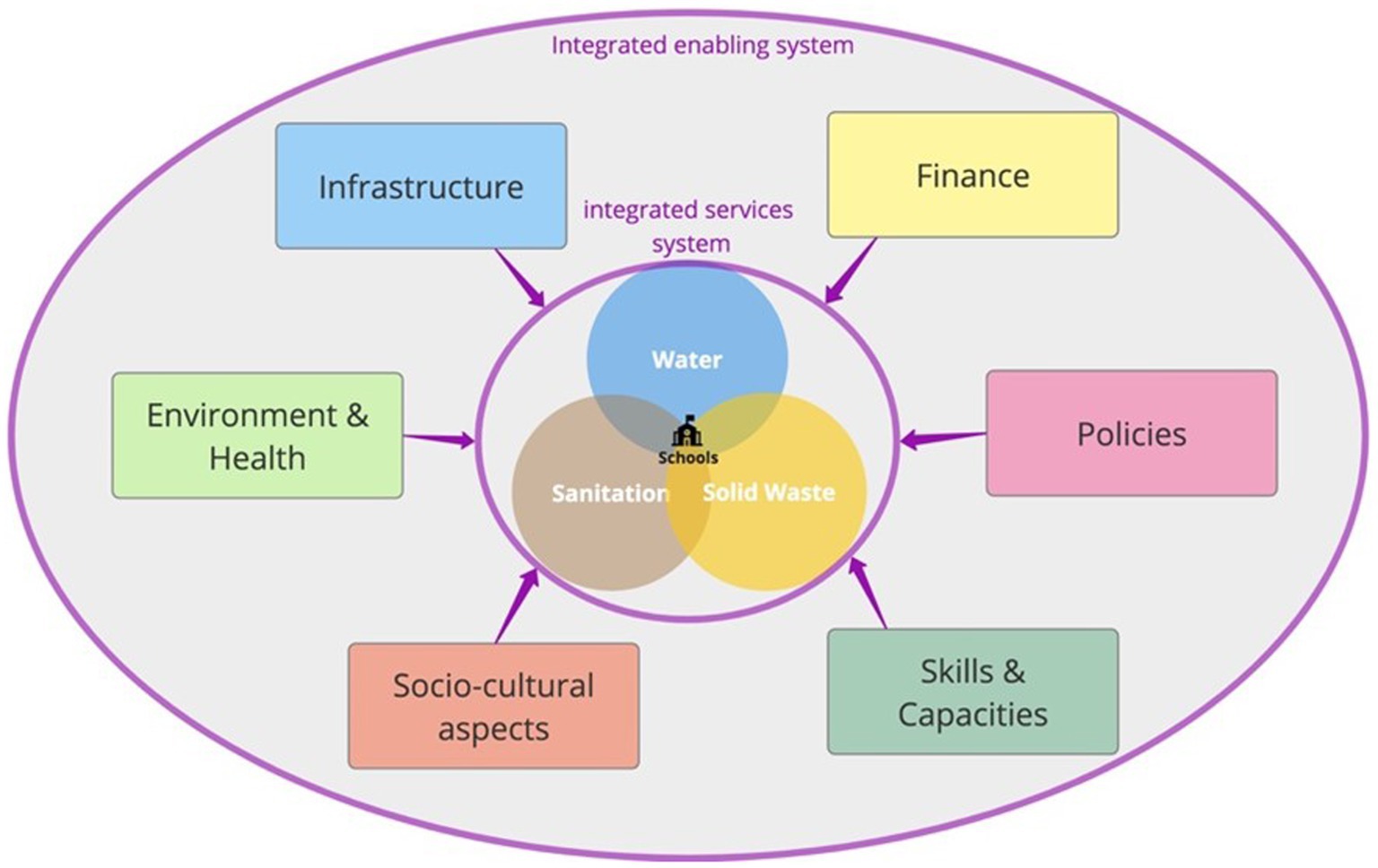
Figure 1. Schematic representing the approach used for this research. The focus is at the centre, with the integrated services system for schools. The integrated enabling system is also looked at, in its influence on the integrated services system.
2.3 Qualitative data collection: surveys, observations, and interviews
A novel integrated survey was developed to elucidate the integration of water, sanitation and solid waste services based on different existing tools such as the JMP Assessment of WASH in Schools, Eawag’s Safe Water Project questionnaire, the FACET tool, and the WHO assessment for Health Care Facilities (HCFs) (UNICEF and WHO, 2021b; Schelbert et al., 2020; UNECE and WHO, 2022). The novel aspect lies in the assessment of all three sectors together as well as direct questions and observations on influences from one sector to another, e.g., is solid waste disposed of in the latrines? Or is there a risk of seepage contamination of the water source? A 30-min questionnaire was targeted at school representatives and was followed by observations in the school and its vicinity to identify interlinkages and verify the reported service levels. Consent of the research participants was obtained after taking a first visit to all selected schools with the presence of a town council member, informing the schools about the context and implications of the survey.
Semi-structured key informant interviews were held independently with the respective town clerks, the town council health inspectors, the town’s piped water supply managers, and district education officers. Additionally, an interview was held with the senior education officer in charge of WASH in schools, from the Ugandan Ministry of Education and Sports. The questions helped gain insights into the development of water, sanitation and solid waste services in schools to its current status, the challenges and influencing factors acting on the service provision. The interviews for schools and key informants of Wobulenzi and Kakooge were held between February 2023 and March 2023. This period of the year was the start of the rainy season, when the first heavy rains were experienced. Additional questions were asked about the water supply in the dry season for comparison, but the corresponding data is only based on participant’s responses. Analysis of the data was mostly conducted in Switzerland only after all field work was finished. The questionnaire and interview guides are provided as Supplementary material.
2.4 Quantitative data collection: water quality measurements
Water quality measurements were taken after the interview at each school visited from various sources. Table 1 describes which methods were used to measure faecal bacteria, pH, free chlorine residuals and turbidity.
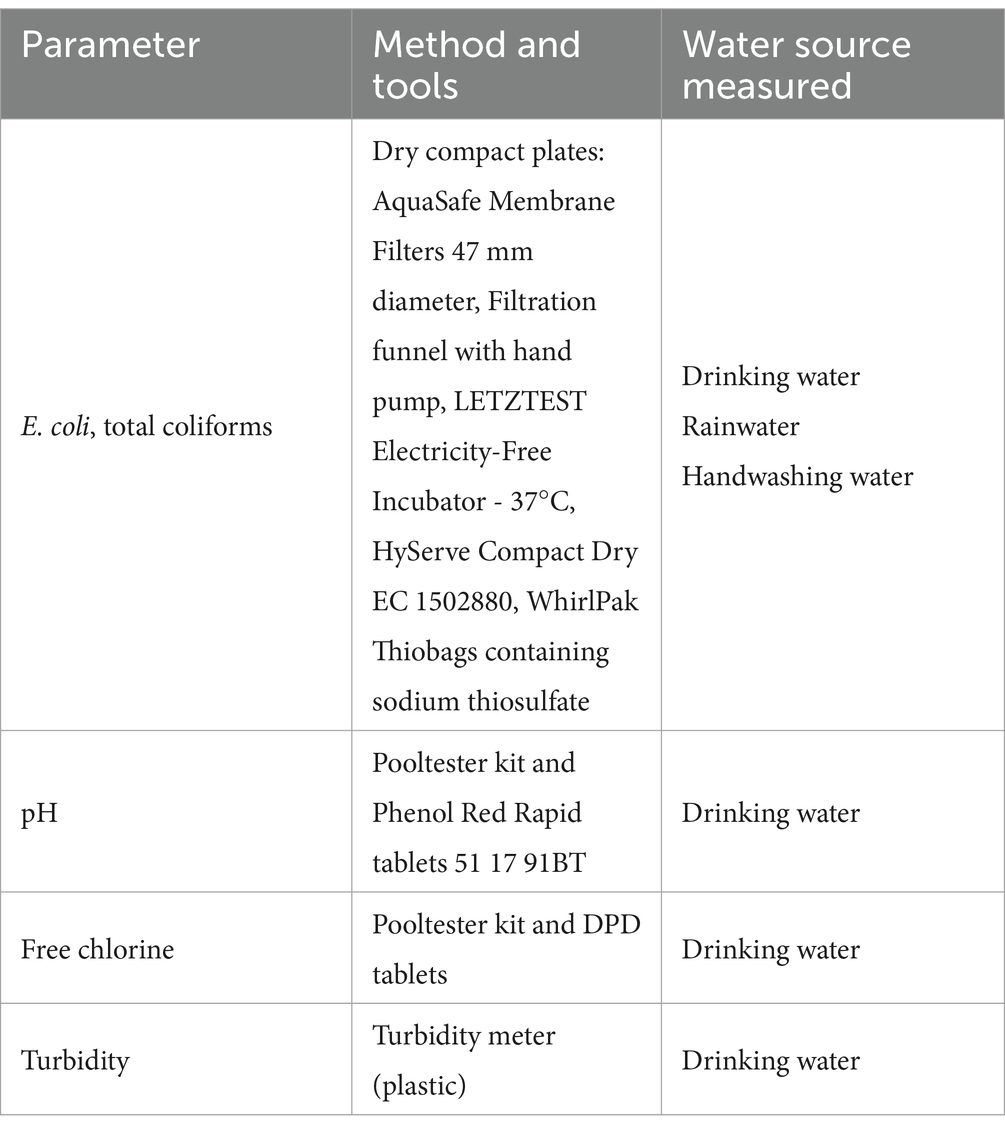
Table 1. List of measured parameters with their respective methods and type of water source measured.
The water samples and measurements were taken during the observations part of the surveys at the source directly for drinking water, rainwater and handwashing water according to the procedure by Meierhofer and Shrestha (2020). Samples were collected directly into sampling bags from hand-pumped bore or dug wells, or taps for piped and filtered water, and outlets for rainwater and handwashing water. The measurements for faecal bacteria were conducted within 6 h after sampling in an incubator in situ (Meierhofer and Shrestha, 2020).
2.5 School selection
A total of 16 private and public schools were chosen according to the education level, the location in the town and the size of the schools (see Table 2). All combinations except a small public school in Wobulenzi, a large private school and a medium-sized public school in Kakooge were part of this study. A full list of all schools and their characteristics as well as their location can also be found in Supplementary Table 1. One extra school in each town was visited first to test the questionnaire and logistics, the data was however not considered.
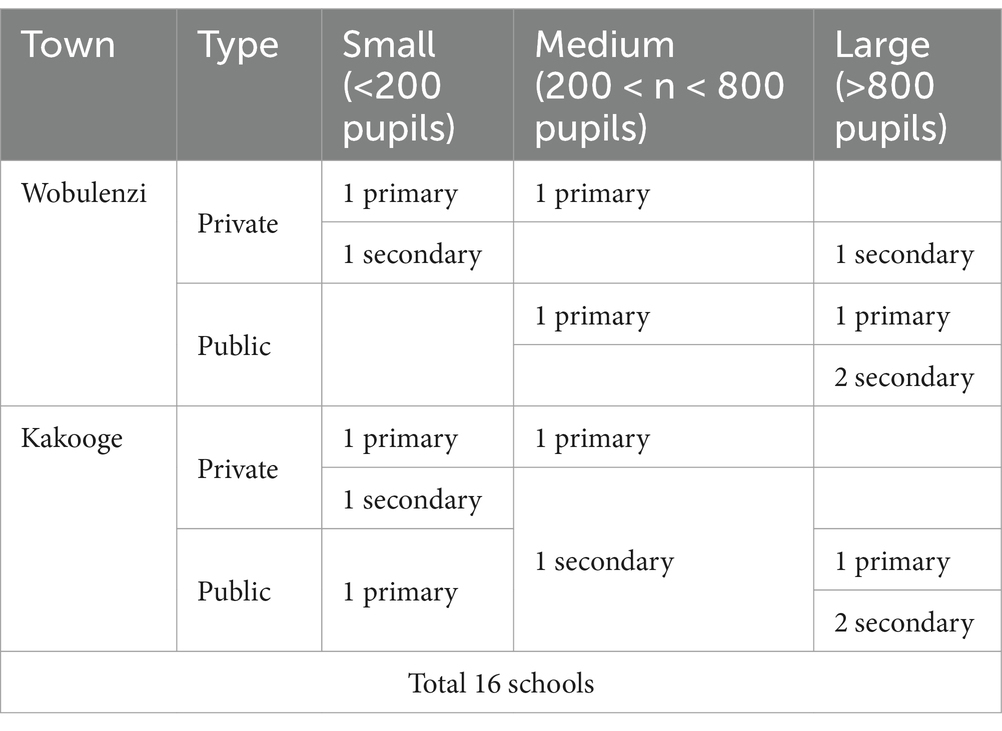
Table 2. List of categories of schools selected for both towns according to their type, size (small, medium and large) and education level.
2.6 Data management and analysis
Survey data was collected using the KoboCollect application on Android smartphones in offline mode and uploaded to the server the same day after field work. Data analysis was done on a Microsoft Excel file. The interview notes and a written transcription, if audio had been recorded, were analysed for understanding the integrated technical and enabling systems. To develop an overview of the WASH and SWM service provision in schools, a modified version of the JMP service ladder methodology was used. The criteria for each level and sector are provided in Section 3.4.
3 Results and discussion
3.1 Water supply services
The water sources used at the schools were groundwater and rainwater, with one exception using surface water (pond) for emergencies. Groundwater was provided through boreholes, dug wells or piped network and rainwater was harvested from the school roofs and stored onsite in different types of tanks. Supplementary Table 2 displays the percentages of schools using water source for different uses. Borehole and rainwater harvesting largely surpassed all other abstraction methods for all water uses, as represented in Figure 2. Drinking water also consisted mostly of groundwater (the source “dug well” was also sometimes misinterpreted as “borehole” by the respondents). In most cases, schools used more than one source explaining why the percentages do not add up to 100% in Figure 2.
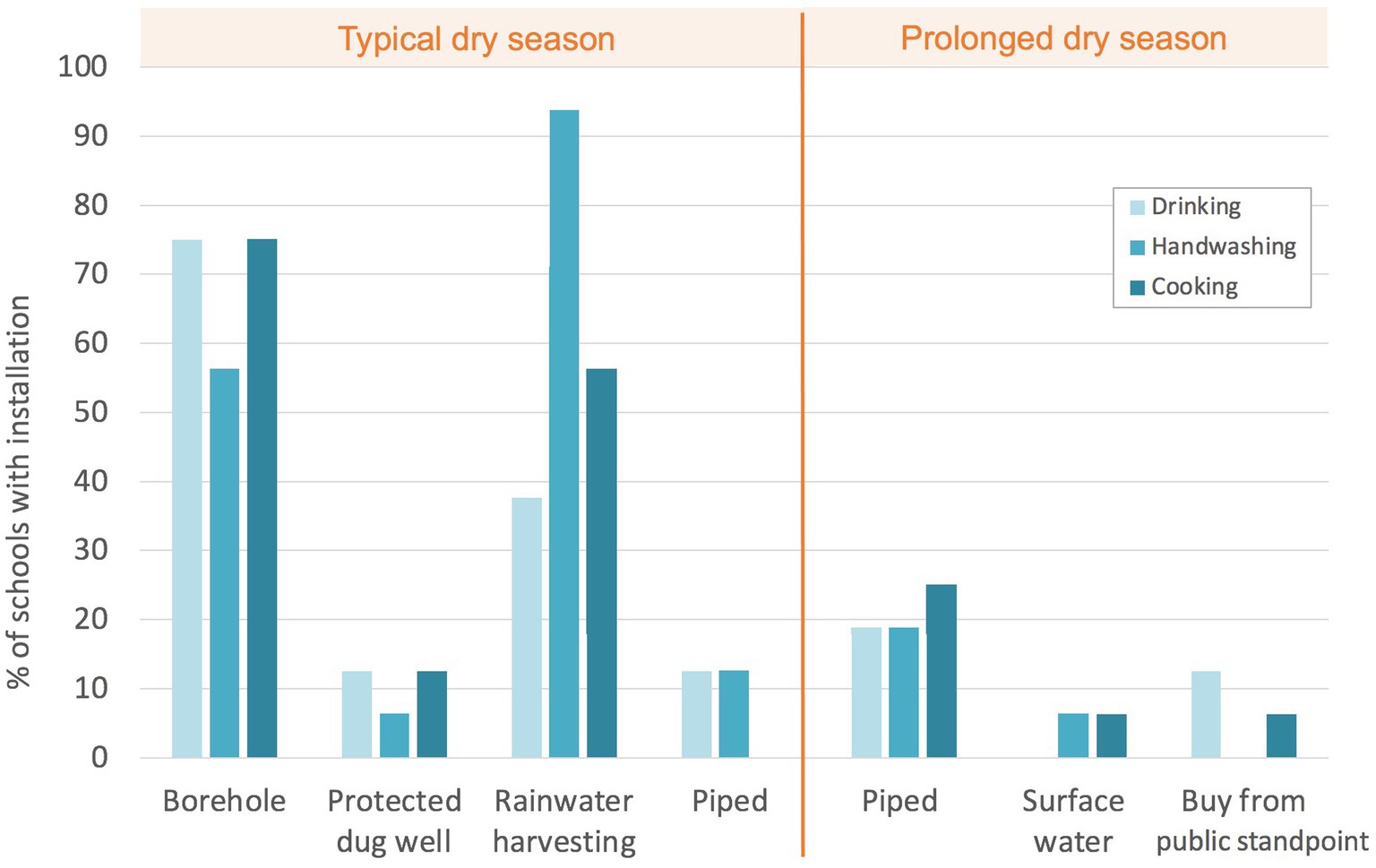
Figure 2. Percentage of schools using a certain abstraction method for a certain water use. The orange line separates a typical dry season situation (left) from a prolonged dry season (drought) (right).
It is a major finding for urban planning of water supply to observe that there is an important source switching practice for schools to provide enough water throughout the year. Similar source switching practices were observed elsewhere in Ugandan small towns (Marks et al., 2020). This is also visible from Figure 2, representing the case of drought or prolonged dry season. Thirty-eight percent of the schools mentioned experiencing water shortage in such periods, needing to find an alternative to their main source of water. Most of those schools reportedly turned to piped water despite higher expenses. One school mentioned fetching surface water from a nearby pond in case of complete water shortage, and two mentioned buying water from a public stand point, at the school’s expenses. In each town, only one school used piped water as their main water source although other schools were also within reach of the piped water supply system. The failure to piped water was linked to the high costs of supply from this service while for others in rural parts, the water supply network had not yet been expanded to those areas.
Furthermore, water quality was measured for drinking water sources at each school to support the data with quantitative results. The compact dry plates methodology identified the presence of faecal bacteria, i.e., E. coli and total coliforms in drinking water samples. Seven of the schools visited mentioned always treating their water. The treatments applied were in 50% of the cases boiling and 50% filtration, which significantly reduced the bacterial presence in most cases (Figure 3). Although the school data set was small, still more than half of the schools did not treat their water prior to consumption. Nine out of 10 samples from these schools contained bacteria, five of which contained E. coli, lying above the 0 CFU recommended by the WHO for drinking water (WHO, 2022). The pH value for samples of borehole or dug well water lied always below 6.8 on the pool tester and otherwise reached between 7.4 and 7.6 for rainwater and one case of piped water. Turbidity was always below five NTU except one school in Wobulenzi which showed 110 NTU from a borehole or dug well after a rain event. The free chlorine residuals were below detection in all the water samples.
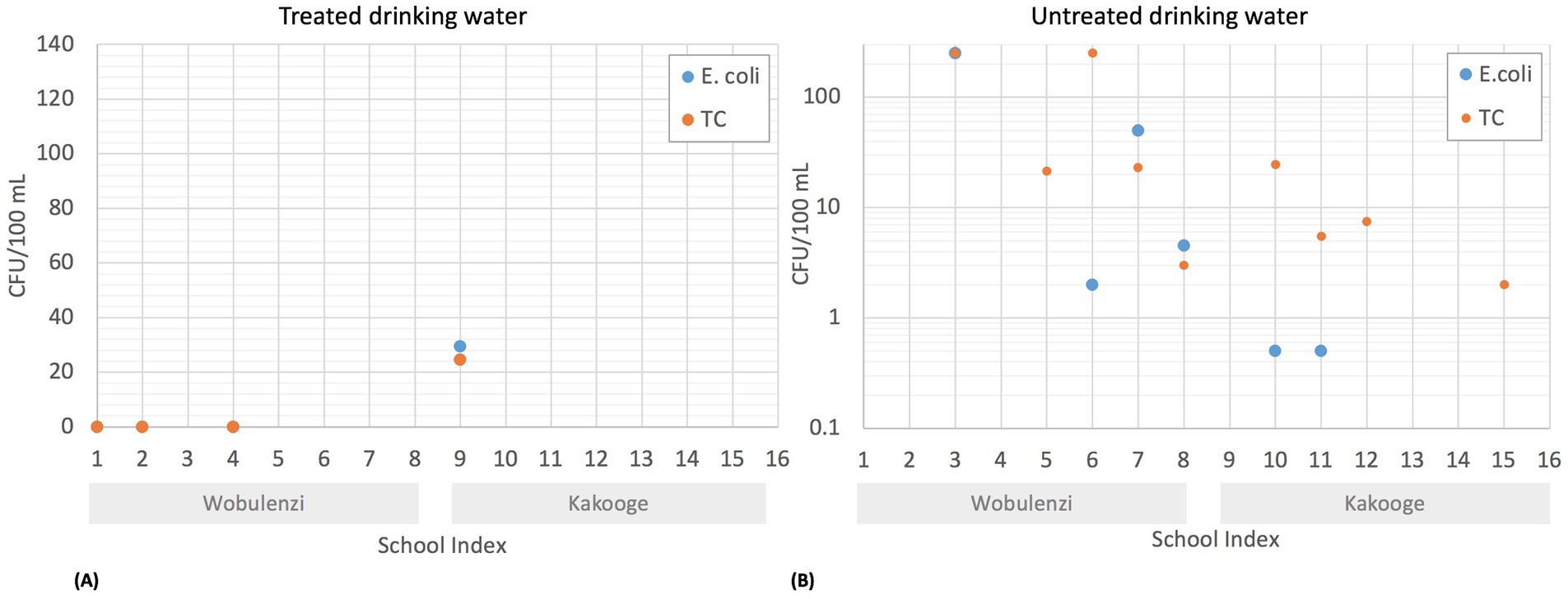
Figure 3. (A) Untreated drinking water sample results for E. coli (EC) and total coliforms (TC) measured in CFU/100 mL. Average values of two measurements. (B) Treated drinking water sample results. The first eight schools are from Wobulenzi and the last eight schools are from Kakooge.
Most schools did not employ treatments before consumption due to financial constraints for boiling or filtration. Notably, in Kakooge, the smaller town, many schools perceived borehole water as safe, yet teachers opted to bring their own drinking water bottles. Overall, the water supplied at schools was generally not safe for children. Even the piped water from the town’s network contained bacteria when the school did not treat it, and the absence of free chlorine residual in piped water samples indicates no capacity to counter post-treatment contamination at the collection point. This relates to similar observations about ineffectiveness of chlorination in small piped networks (Crider et al., 2022).
3.2 Sanitation services
Generally, 15 of the schools provided gender-separated pit latrines for boys and girls. One large secondary school in Wobulenzi additionally had 10 cistern-flush squat latrines per gender leading to soak pits, but the flush system was broken. Another school in Wobulenzi had pour squat toilets leading to a pit. All schools mentioned needing more latrine stances, especially after the COVID-19 pandemic. A total 63 and 75% of schools respected the national ratio of 40 students per stance for girls and boys, respectively, (UNICEF, 2017). Schools faced significant challenges in maintaining latrine infrastructure due to issues such as breakage, full pits, termite damage, and leaky latrine roofs. Inadequate personnel and financial resources hindered the necessary upkeep. Consequently, 15 out of 16 schools had either dirty or damaged latrines.
Government and private schools lack a dedicated budget for WASH initiatives, with priority allocations directed toward scholastic materials and furniture. Public schools receive a Universal Primary/Secondary Education (UPE or USE) grant, which includes a fixed threshold, and supplementary funds based on enrolment (Uganda Ministry of Education and Sports, 2015). Unfortunately, the grant allocated to schools is frequently delayed or incomplete, exacerbated by the financial strain on parents’ difficulties in paying school fees. This has evident repercussions on inadequate handwashing facilities, with stations often insufficient in number, and these facilities likely to be empty before lunchtime. Only 19% of schools met the national standard ratio of 40 students per handwashing facility, while 31% doubled that ratio. These statistics are consistent with other such findings in schools in sub-Saharan African context such as Ghana and Zambia (Nkonde et al., 2025; Harvey and Adenya, 2009).
Identifying the containment status of faecal waste in pit latrines proved challenging as interviewees lacked this information. Merely two schools mentioned having lined containment without specifying whether it is fully or partially lined. However, 25% of schools reported regular pit emptying when filled, utilizing emptying trucks from Kampala. Though this practice might imply fully lined containment, there was no certainty. Kakooge has a new faecal sludge treatment plant (FSTP), but with minimal evidence of receiving faecal sludge. Interviews with town council members indicated a lack of lining in Kakooge’s pits, as an impediment to effective emptying and limiting faecal sludge delivery to the FSTP. Nonetheless, a new bylaw mandates the construction of septic tanks for new buildings, aiming to enhance the town’s sanitation service.
3.3 Solid waste services
Schools reported that 63% of their solid waste was primarily inorganic, while 37% indicated a roughly equal division between organic and inorganic waste. Although the exact percentages remained undetermined, visual assessments suggested that more than half of the waste comprised inorganic materials. This fraction mainly comprised plastic bottles, packaging, paper, small metal components, cardboard, and sanitary items. Organic waste mainly consisted of tree leaves and branches from the compound. Food waste at the schools’ dumping sites was minimal, with any kitchen waste typically mixed with water in a jerry can for pig feed. The meals provided produced negligible organic waste due to minimal leftover. The quantity of organic and inorganic waste generated was not precisely measured. Instead, the focus was on identifying the types of waste present and the management practices employed. Only one school (in rural Kakooge) actively segregated waste into categories: plastic bottles for informal collection, paper for potential use as toilet paper during shortages, and urine collected in jerry cans for fermentation into fertilizer for school crops. The school’s remote location from town waste facilities prompted segregation to bridge financial gaps by conserving resources. Regarding waste storage at schools, findings showed an even distribution: 31% had one container per classroom, 38% had a single container for several classrooms or the entire school, while 31% lacked any containers. Cleaning personnel managed storage and emptying in three Wobulenzi schools, while in others, it was typically handled by pupils or teachers. Containers, made of plastic, cardboard, metal, or, in the cleanest school, rice bags held by metal poles, received waste from classrooms, students, and teachers.
Solid waste management within school premises accounted for 87% of cases among the 16 schools surveyed. For two schools in Wobulenzi, waste collection was external; a smaller primary school had weekly routine collection by the town council’s waste truck, while a larger secondary school received daily collection by a private company. However, irrespective of collection methods, all waste, collected or not, was ultimately disposed of through open burning, either on school grounds or in a large (unmanaged) town dumpsite (hence the 100% in Figure 4), where in 13% of schools that had a waste collection, the collected waste ended up in the town’s dumpsite. The percentages in Figure 3 show the number of schools for which a specific step was observed, they are not cumulative. Regarding specific waste treatment, three schools possessed incinerators for sanitary pads to avoid disposal in latrine pits or open dumps, reducing health, environmental, and infrastructure risks. Although most schools recognized this sanitary waste management method, financial constraints hindered the construction of such facilities.
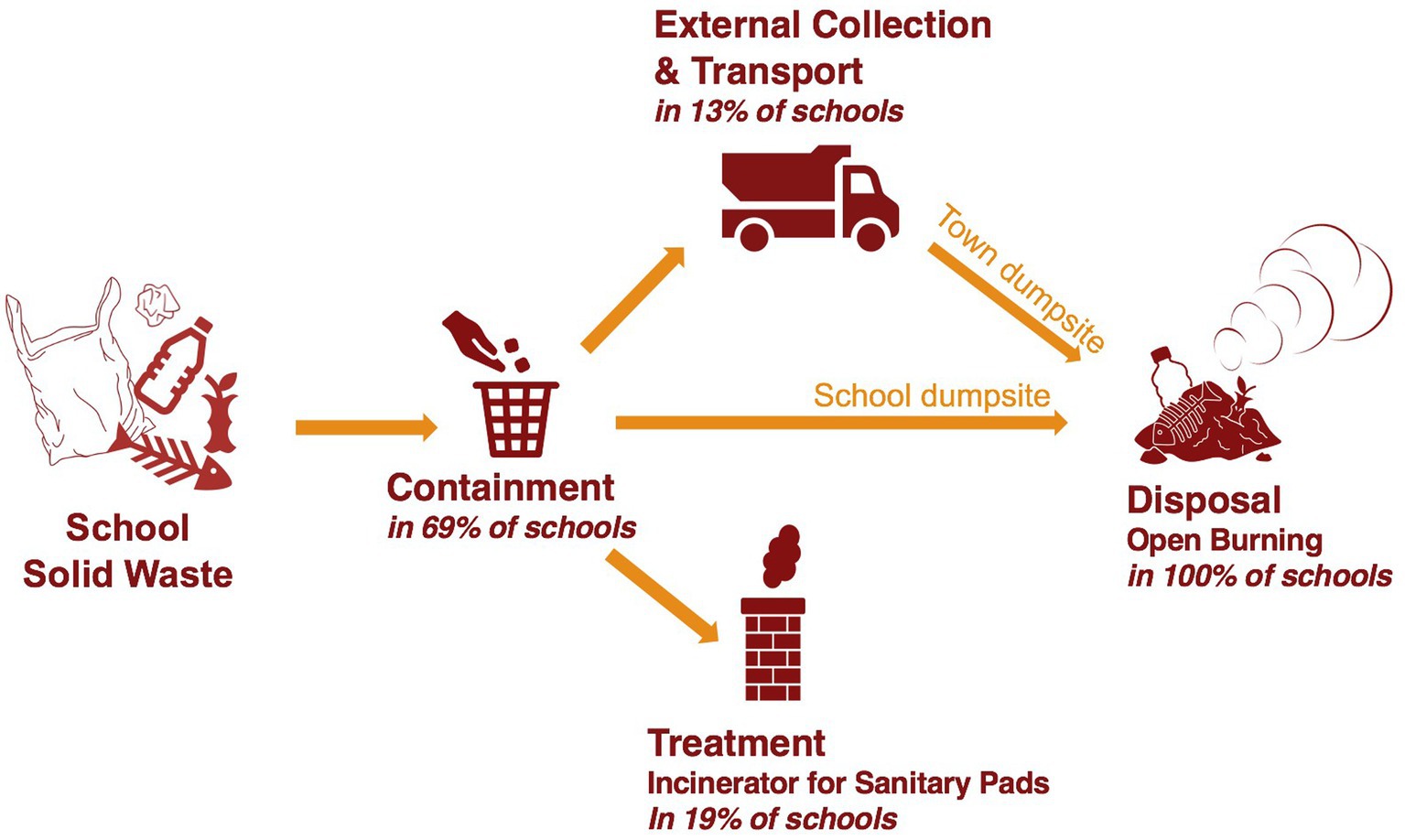
Figure 4. Representation of percentage of schools having external collection, treatment and the type of disposal for solid waste. Values are not cumulative.
Schools engaged in open burning practices at different frequencies, typically at least once a week. Some schools conducted burning activities on weekends, afternoons, or daily during dry seasons. Pupils were exposed to the fumes of different intensities based on dump location and burning frequency. Two schools, one in Wobulenzi and another in Kakooge, had scattered dumps leading to pervasive open burning, potentially affecting nearby classrooms with smoke. Open burning is a widespread practice in town areas, even on streets, posing constant potential exposure to smoke and toxic fumes for residents. This is also highlighted in a recent publication that burning of plastic waste has been estimated to be the major plastic waste emission pathway worldwide (Cottom et al., 2024).
Solid waste management was mainly perceived as maintenance of school cleanliness and varied based on space and budget constraints. While schools prioritized maintaining clean premises, some faced challenges due to limited human resources. Concerns regarding the toxicity of fumes or pollution from waste dumps or pits were generally not acknowledged by schools. Overall, solid waste management receives less attention from authorities compared to water and sanitation. The SWM practices on littering, dumping and burning in schools were similar to previous findings in Nigeria (Ana et al., 2011) and South Africa (Owojori et al., 2022).
3.4 JMP service ladder for schools and proposed modification
As discussed earlier, the JMP’s WASH service ladder for schools is a widely used monitoring methodology, yet has limitations in capturing the challenges in the situations accurately especially regarding temporal variations and quality of the service. In this study, a direct application of the same methodology in schools result that all schools have basic WASH services (the highest level as per the method), yet the results described above show that the situation has far more challenges. A visual comparison (Supplementary Figure 1) between the national level service levels in schools and the 16 schools studied show a probable misrepresentation of the actual situation. Firstly, issues arise namely in the case of drinking water where the indicators do not separate different seasons, these results thus only representing a time when drinking water was naturally available abundantly due to the previous rainy season. Secondly, this representation suggests that the schools are providing a basic service, even though bacteria was present in drinking water samples. Thirdly, the presence of an improved source or a treatment infrastructure does not mean the outcome is safe. Fourthly, SWM is left out and does not have indicators.
A variation of the indicators was consequently suggested for this study, with the addition of two levels, Poor and Advanced Basic Service and the category of solid waste management. A detailed definition of the specific levels is available in Figure 5. The existing levels were also adapted to a finer level of detail, which enabled to represent the data as shown in Figure 6. Looking at the level of Advanced Basic Service, it is understandable that for all categories it has not yet reached 50% of the schools, unlike what the original indicators were suggesting.
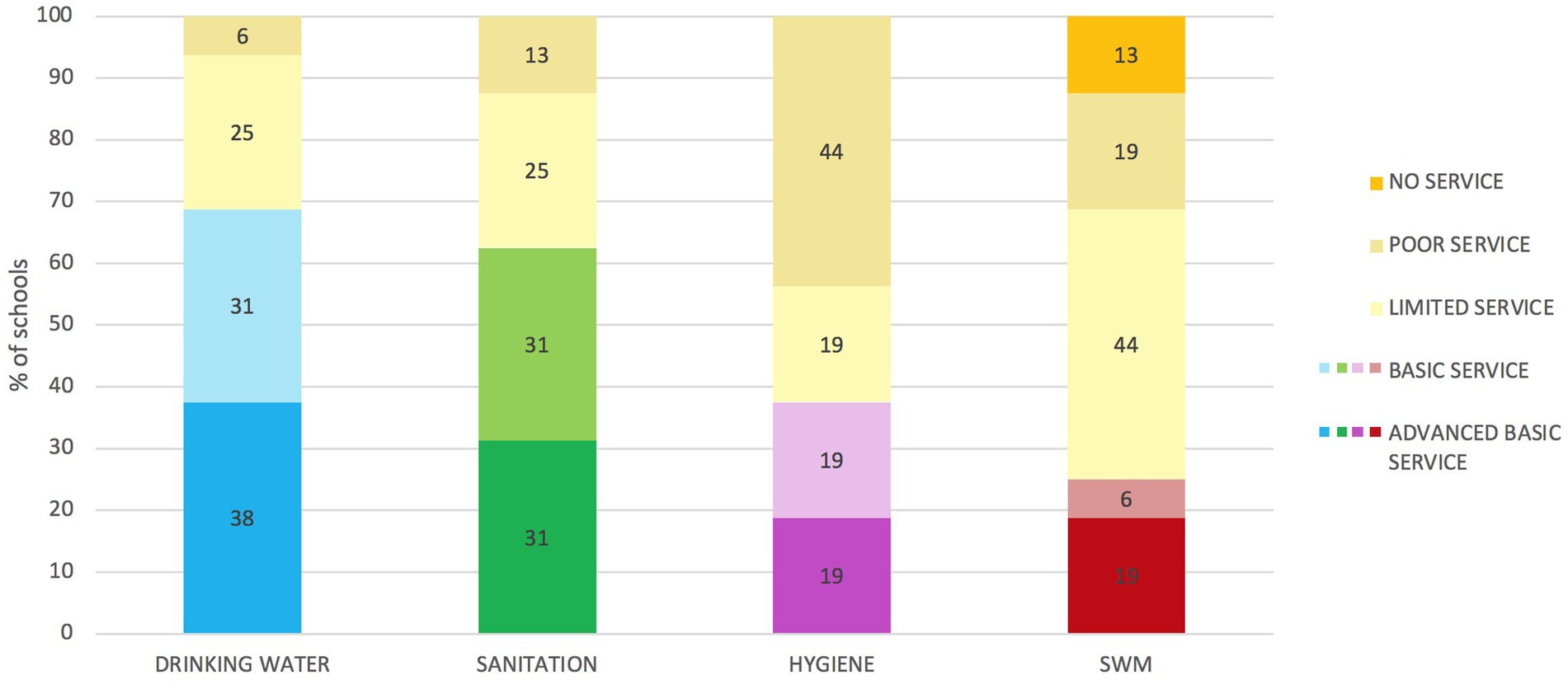
Figure 6. Representation of school data from this study with the adaptation of the JMP service ladder indicators.
An important reason for refining the Basic Service into two levels was to distinguish the presence of treatment for drinking water as well as the locally accepted national ratio for latrine stances and handwashing facilities. A single latrine used by 40 students will not be in the same state as if used by 90. Also emphasized is the availability of the handwashing facilities, especially if 40 versus 350 students are expected to wash their hands before lunch using the same station. These numbers were observed within this study, importantly highlighting that existing national ratios are not met. With these adapted indicators, it is possible to see that the service provision for hand hygiene and SWM was critical.
As mentioned earlier, SWM lacks acknowledgement of its pollution and health problems and not only at the local level, which again emphasizes this critical state, as also mentioned by Cottom et al. (2024). The level of No Service for SWM corresponds to the cases where no containers were used to gather waste in the classrooms or the compound, thus resulting in dirty spaces where children would learn or play. The schools that segregated types of waste such as polyethylene terephtalate (PET) bottles, paper, greywater from cooking, and food for animals either had an external collection of their waste or disposed of it in a specifically designated area of the compound were considered to have an Advanced Basic Service. Such a refined classification also aims at avoiding the “higher” levels on the ladder overshadowing the necessity to improve the “lower” levels like No service or Poor Service. These changes are proposed to highlight the limitations observed in the implementation of the current ladder, however further refinement is necessary to ensure its relevance and suitability for wider adoption.
3.5 Sectoral interlinkages
During visits to the schools, 12 interlinkages were identified through observations as per the questionnaire and information from school representatives. These interlinkages were categorized into interactions causing negative outcomes, termed as negative interlinkages, and positive outcomes, defined as positive interlinkages.
Seven interlinkages were identified as negative, as depicted in Figure 7A. Stormwater played a significant role in most of these linkages, either through infiltration, soil drainage or surface runoff. These interlinkages were not quantified but rather presented as justified pathways that show correlation with the water quality measurements and interview data, where applicable. For example, the absence of lining in pit latrines and waste pits, coupled with two annual rainy seasons, implies significant seepage and leakage, coinciding with water quality results in nearby sources. Such occurrences can impact sanitation services (e.g., flooding pits affect faecal sludge degradation) and solid waste management (e.g., flooded dumpsites hinder burning and cause wet waste accumulation or dispersion). Additionally, these services can influence groundwater quality. Moreover, the open burning of solid waste, known to affect rainwater quality by generating toxic fumes leading to acid rain, can further deteriorate rainwater quality. Rainwater is another source of water used by many and its pollution can have harmful consequences on public health and the environment.

Figure 7. Schematic of the identified positive (A) and negative (B) interlinkages between the sectors. The arrows show which sector causes an impact on another sector and the dashed lines represent linkages outside of school grounds. The numeric values represent the percentage of schools for which a certain pathway was observed.
The five remaining interlinkages were identified as positive and are presented in Figure 7B. Additionally, positive connections from the three sectors are depicted, similar to those assessed by Narayan et al. (2021). These connections were quantified based on the percentage of schools where the interlinkage was observed. Rainwater harvesting was a prevalent practice, serving as a crucial water source for handwashing stations and flush toilets in nearly all instances. Urine collection for fertilizer production and paper reuse as toilet paper was observed only in one school in Kakooge, as previously mentioned. Although the adoption of these practices is driven primarily by financial constraints in schools, it highlights the importance of awareness and creativity in integrated approaches.
3.6 Integrated enabling system
The six enabling environment factors (Figure 1) were investigated to understand their influence on interlinkages and ultimately on service provision. The gathered data, primarily from interviews, are discussed as follows:
3.6.1 Finance
The financial resources related to the services of water, sanitation and solid waste in schools were very limited. Budgets lacked specific allocations for WASH/SWM, focusing instead on teaching materials, furniture, and salaries.
Public schools are to receive a universal primary/secondary education grant (UPE/USE) every year, with an amount according to the school size (for UPE: 360$ + 4.5$ per pupil) and also collect funds through the parent–teacher association (PTA). In reality, the promised grants would not suffice to cover the WASH/SWM expenses, were they even paid in entirety and without considerate delays. Private school rely entirely on PTA fees and all 16 schools mentioned the difficulty of collection, often receiving barely 50% of needed funds. This results in dire financial conditions for most schools, some even failing to pay their teachers and staff, hindering the maintenance of WASH and SWM.
3.6.2 Policies
Guidelines for WASH in Ugandan schools exist such as the WASH operation manual for schools (GIZ, 2017), the three-star approach (Uganda Ministry of Education and Sports, 2017) and the handbook for operation and maintenance of WASH facilities in schools in Uganda (Uganda Ministry of Education and Sports, UNICEF, Uganda Ministry of Health, 2023). However, these frameworks are fragmented and lack a unified approach for schools in planning their WASH service. Furthermore, SWM lacks attention within these frameworks. Guidelines establish information on what should be provided in schools (Uganda National Bureau of Standards, 2014), but no implementation strategy is suggested and governmental support at different levels is low. For example, district education officers mentioned a new law that mandates every new construction to have lined containments in order to empty faecal sludge regularly. However, it is at the cost of the school’s budget, and no monitoring or enforcement is done. Different ministries are involved in WASH in schools, namely the Ministry of Water and Environment, the Ministry for Education and Sports and the Ministry of Health, which increases the complexity in policy coordination and decision-making. An integrated approach could potentially provide a framework that can support a comprehensive WASH and SWM in schools’ policy.
3.6.3 Infrastructure
Sustainable alternatives to conventional approaches have been observed such as urine collection for fertilizer production or black soldier fly farming techniques (outside of field work) but the accessibility is still low. Water treatment technologies or circular sanitation systems like urine-diverting dry toilets (UDDT) exist in Uganda but are often too difficult to afford for schools.
3.6.4 Skills and capacities
Schools recognized the importance of WASH and mentioned receiving local or regional inspection at different frequencies. The challenge relied however on the operation and maintenance of WASH and SWM practices and infrastructures as mentioned earlier. Handwashing and latrine cleaning were poorly managed, and solid waste management was seen as merely grounds maintenance. As mentioned in section 3.3, toxic fumes and leachate from the waste dumps were not acknowledged by the schools as open burning was commonly practiced in the towns. In terms of awareness of the interlinkages, there may be a need to educate the service provided both within and outside the schools on the detrimental effects of poorly managed services.
3.6.5 Socio-cultural aspects
Teachers explained that for small towns and especially rural regions, education was not always valued at the family level. Some parents would prefer to keep their children engaged in household tasks or agriculture activities rather than going to school. Especially young single mothers tended to disregard education and struggled the most to pay their fees. Teachers also noted poor hygiene habits among the youngest children due to a lack of practices at home, affecting the school’s cleanliness and hygiene. Behavioral habits and lack of awareness could pose a barrier to WASH and SWM practices, raw borehole water was considered safe among a part of the schools. However, considerate efforts toward safe menstruation were observed, as all schools mentioned providing sanitary pads for emergencies and incinerators construction was contemplated for the schools that did not have one.
3.6.6 Environment and health
As the impacts of climate change become more pronounced, seasons in Uganda are no longer as stable and predictable (Nakate, 2021). Climate change is leading to hotter dry months and more intense rainfall, significantly impacting the interlinkages between water, sanitation and solid waste services through stormwater management, flooding, and drought. For example, floods could exacerbate water contamination and clogging of drainage channels through littering. A study on the comprehensive impacts of climate change on such interlinkages is needed. Current infrastructure in schools is vulnerable and ill-equipped to handle these climatic stressors. Additionally, inadequate waste containment raises the risk of disease transmission, intensifying the existing burden of malaria in the area. To effectively address these challenges, integrated approaches are essential for the sustainable planning and implementation of resilient infrastructure.
3.7 Limitations of the study
This study is limited by the geographical focus on schools in only two Ugandan towns. While it reflects situations in several towns, it does not capture the full diversity and complexity of WASH and SWM in Schools across Uganda or globally. Through this research, important issues of service provision have been identified, but are strongly context-specific. Further assessments at a similar scale and background are necessary to obtain robust results on the situation in schools of LMICs. Another potential for improvement of the quality of the results would be to quantify not only the positive but also the negative interlinkages, as this could not be completed in this study.
4 Conclusion
This research investigated the challenges in water, sanitation, and solid waste management provision in schools in two Ugandan towns. The current state of water, sanitation, and solid waste services in the selected schools revealed significant issues in quality, sustainability, safety, and environmental impact. Notable findings included E. coli and coliform contamination in drinking water, insufficient handwashing facilities, inadequate latrine infrastructure, and virtually non-existent solid waste management.
The study revealed limitations in the commonly used JMP service ladder for WASH in schools, primarily due to their generic categorization and lack of detail. Proposed modifications to the service ladder and its indicators show promise in more accurately depicting temporal variations and service quality, addressing the current JMP framework’s shortcomings. To enable fair and accurate comparisons, more detailed classification is necessary, even if it entails a more complex framework, data collection, and analysis. The inclusion of SWM indicators adds value beyond SDG 6.
The study also identified 12 positive and negative interlinkages through a mixed-methods approach. By linking issues and benefits to specific steps in the service chain, the study underscored the necessity for integrated planning to mitigate negative interlinkages causing service failures and leverage synergies for positive outcomes. The innovative integrated assessment of these sectors proved instrumental as an initial step toward holistic planning, moving beyond siloed approaches.
The integrated enabling system provided underlying reasons for the current state of service provision, and for understanding the interlinkages. These include policies, finances, skills, and capacities, presenting levers for improvement. Overall, policy changes within the context of WASH and SWM in Ugandan schools would benefit from noting these interlinkages and adopting an integrated approach to addressing challenges in these interconnected sectors. In conclusion, this research emphasizes the urgency for integrated perspectives in basic services that enable management of these services as well as their interlinkages, ultimately benefiting schools and their surrounding communities.
Data availability statement
The datasets presented in this study can be found in online repositories. The names of the repository/repositories and accession number(s) can be found at: https://doi.org/10.5281/zenodo.14316809.
Ethics statement
This research was approved by the Ethics Committee at Eawag (16-09/WABES) and by the Uganda Vector Control Division Research Ethics Committee (VCDREC168). Appropriate ethical guidelines were followed throughout this study.
Author contributions
CF: Conceptualization, Formal analysis, Investigation, Writing – original draft, Writing – review & editing. CL: Project administration, Supervision, Writing – review & editing. CN: Supervision, Writing – review & editing. EM: Supervision, Writing – review & editing. AN: Conceptualization, Project administration, Supervision, Writing – review & editing.
Funding
The author(s) declare that financial support was received for the research and/or publication of this article. This work was financed by the Swiss Agency for Development and Cooperation (Grant no. 8107-4222 (SDC-WABES)). Open access funding was provided by Swiss Federal Institute of Aquatic Science and Technology (Eawag).
Acknowledgments
We extend our gratitude to the town councils and the schools of Wobulenzi and Kakooge who supported this study through their invaluable participation and insights. Finally, we acknowledge the support and advice from our colleagues at Eawag-Sandec, particularly the members of the WABES project, which greatly helped in the framing and execution of this research.
Conflict of interest
The authors declare that the research was conducted in the absence of any commercial or financial relationships that could be construed as a potential conflict of interest.
Generative AI statement
The authors declare that no Gen AI was used in the creation of this manuscript.
Publisher’s note
All claims expressed in this article are solely those of the authors and do not necessarily represent those of their affiliated organizations, or those of the publisher, the editors and the reviewers. Any product that may be evaluated in this article, or claim that may be made by its manufacturer, is not guaranteed or endorsed by the publisher.
Supplementary material
The Supplementary material for this article can be found online at: https://www.frontiersin.org/articles/10.3389/frwa.2025.1544779/full#supplementary-material
Abbreviations
CFU, Colony forming units; DALY, Disability-adjusted life year; FSTP, Faecal sludge treatment plant; HCF, Healthcare facility; JMP, Joint Monitoring Program; NTU, Nephelometric turbidity unit; NWSC, National Water and Sewerage Corporation; PET, Polyethylene terephtalate; PTA, Parent–teacher association; SWM, Solid waste management; UDDT, Urine-diverting dry toilets; UNICEF, United Nations International Children’s Fund; UPE, Universal primary education; USE, Universal secondary education; WHO, World Health Organization.
References
Ana, G., Oloruntoba, E. O., Shendell, D., Elemile, O. O., Benjamin, O. R., Sridhar, M. K., et al. (2011). International perspectives: solid waste management problems in secondary schools in Ibadan, Nigeria. J. Environ. Health 74, 24–28.
Bolatova, Z., Tussupova, K., Toleubekov, B., Sukhanberdiyev, K., Sharapatova, K., Stafström, M., et al. (2021). Challenges of access to WASH in schools in low- and middle-income countries: case study from rural Central Kazakhstan. Int. J. Environ. Res. Public Health 18:9652.
Cottom, J., and Cook, E. &. Costas, V., (2024). A local-to-global emissions inventory of macroplastic pollution. Nature, 633, p. 101–108. doi: 10.1038/s41586-024-07758-6
Crider, Y., Sainju, S., Shrestha, R., Clair-Caliot, G., Schertenleib, A., Kunwar, B. M., et al. (2022). Evaluation of system-level, passive chlorination in gravity-fed piped water Systems in Rural Nepal. Environ. Sci. Technol. 56:13985. doi: 10.1021/acs.est.2c03133
GIZ (2017). WASH in schools: Operation & maintenance. Bonn: GIZ Deutsche Gesellschaft für Internationale Zusammenarbeit GmbH.
Harvey, P., and Adenya, E. (2009). An assessment of sanitation and hygiene in primary schools in Zambia. Loughborough: Loughborough University.
Lüthi, C., McConville, J., Norström, A., Panesar, A., Ingle, R., Saywell, D., et al. (2017). Rethinking sustainable sanitation for the urban environment. Delft: IFoU. Available at: https://research.tudelft.nl/en/publications/rethinking-sustainable-sanitation-for-the-urban-environment
Lüthi, C., Morel, A., Tilley, E., and Ulrich, L. (2011). Community-led urban environmental sanitation planning: CLUES. Complete guidelines for decision-makers with 30 tools. Dübendorf: Eawag/Sandec.
Marks, S., Clair-Caliot, G., and Taing, L. (2020). Water supply and sanitation services in small towns in rural–urban transition zones: the case of Bushenyi-Ishaka municipality, Uganda. NPJ Clean Water 27:21. doi: 10.1038/s41545-020-0068-4
Marshall, R. E., and Farahbakhsh, K. (2013). Systems approaches to integrated solid waste management in developing countries. Waste Manag. 33, 988–1003.
Meierhofer, R., and Shrestha, A. (2020). Research manual - water quality testing. Dübendorf: Eawag/Sandec.
Narayan, A. S., Marks, S. J., Meierhofer, R., Strande, L., Tilley, E., Zurbrügg, C., et al. (2021). Advancements in and integration of water, sanitation, and solid waste for low- and middle-income countries. Annu. Rev. Environ. Resour. 46, 193–219. doi: 10.1146/annurev-environ-030620-042304
Nkonde, W., Furlong, C., Reed, B., and Brdanovic, D. (2025). Assessing institutional sanitation and its impact at a citywide level: an exploration of school sanitation in the Accra metropolitan area, Ghana. Front. Environ. Sci. 12:1473729. doi: 10.3389/fenvs.2024.1473729
Owojori, O. M., Mulaudzi, R., and Edokpayi, J. N. (2022). Student's knowledge, attitude, and perception (KAP) to solid waste management: a survey towards a more circular economy from a rural-based tertiary institution in South Africa. Sustain. For. 14:1310. doi: 10.3390/su14031310
Poague, K., Blanford, J., and Anthonj, C. (2022). Water, sanitation and hygiene in schools in low- and middle-income countries: a systematic review and implications for the COVID-19 pandemic. Int. J. Environ. Res. Public Health 19:3124. doi: 10.3390/ijerph19053124
Schelbert, V., Renggli, S., Füllemann, N., Mercier, S., and Brogan, J. (2020). Manual: Facility evaluation tool for WASH in institutions (FACET). Dübendorf: Eawag/Sandec.
Scott, P., and Cotton, A. P. (2020). The sanitation cityscape – toward a conceptual framework for integrated and citywide urban sanitation. Front. Environ. Sci. 8:70. doi: 10.3389/fenvs.2020.00070
Uganda Ministry of Education and Sports (2015). Education for all: the Uganda National end of decade assessment of education for all 2001-2010. Kampala: Uganda Ministry of Education and Sports.
Uganda Ministry of Education and Sports (2017). Guidelines for three star approach for planning in wash schools. Kampala: Uganda Ministry of Education and Sports.
Uganda Ministry of Education and Sports, UNICEF, Uganda Ministry of Health (2023). Handbook for operation and maintenance of water, sanitation and hygiene facilities in schools in Uganda. Kampala: Uganda Ministry of Education and Sports.
Uganda National Bureau of Standards (2014). Uganda standard - potable water specification. Bweyogerere: Uganda National Bureau of Standards.
UN (2021). Summary Progress update 2021: SDG 6-water and sanitation for all. Geneva: United Nations.
UN (2022). Education transformation needed for “inclusive, just and peaceful world”. Geneva: United Nations.
UNECE and WHO (2022). Water, sanitation and hygiene in healthcare facilities: a practical tool for situation assessment and improvement planning. Protocol on water and health. Geneva: UNECE and WHO.
UNICEF (2017). Water, sanitation and hygiene in schools. National Standards in Uganda. New York, NY: UNICEF.
UNICEF (2023). Progress on children's well-being: Centring child rights in the 2030 agenda. New York, NY: UNICEF division of data Analytics Planning and Monitoring.
UNICEF and WHO (2022). Progress on drinking water, sanitation and hygiene in schools: 2000-2021 data update. Geneva: UNECE and WHO.
WHO (2021). Compendium of WHO and other UN guidance on health and environment. Chapter 4 solid waste. Geneva: WHO.
Keywords: schools, Uganda, water, sanitation, solid waste, integration, JMP
Citation: Farine C, Lüthi C, Niwagaba CB, Morgenroth E and Narayan AS (2025) Interlinkages and indicators: novel assessment of water, sanitation and solid waste services in schools in two Ugandan towns. Front. Water. 7:1544779. doi: 10.3389/frwa.2025.1544779
Edited by:
Ioannis D. Manariotis, University of Patras, GreeceReviewed by:
Daud Hamidi, Independent Researcher, Herat, AfghanistanAristeidis Bloutsos, University of West Attica, Greece
Copyright © 2025 Farine, Lüthi, Niwagaba, Morgenroth and Narayan. This is an open-access article distributed under the terms of the Creative Commons Attribution License (CC BY). The use, distribution or reproduction in other forums is permitted, provided the original author(s) and the copyright owner(s) are credited and that the original publication in this journal is cited, in accordance with accepted academic practice. No use, distribution or reproduction is permitted which does not comply with these terms.
*Correspondence: Charlotte Farine, ZmFyaW5lY2hhcmxvdHRlQGJsdWV3aW4uY2g=; Abishek Sankara Narayan, YWJpc2hlay5uYXJheWFuQGVhd2FnLmNo
 Charlotte Farine
Charlotte Farine Christoph Lüthi
Christoph Lüthi Charles Buregeya Niwagaba
Charles Buregeya Niwagaba Eberhard Morgenroth
Eberhard Morgenroth Abishek Sankara Narayan
Abishek Sankara Narayan